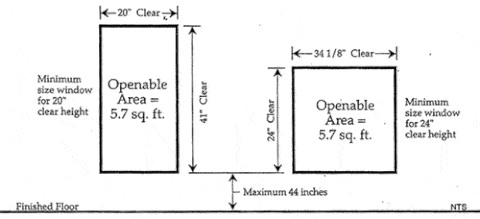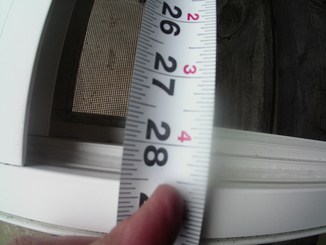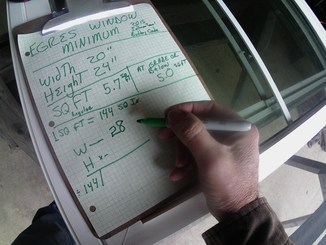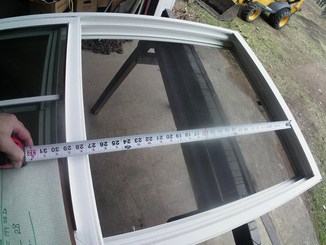Having completed the requirements of a Basic Code Enforcement Training Program in New York State, I will try to answer some of the questions you might have about the building code in the following article. If you would like to read more or purchase your copy
2015 International Building Code
What is an Egress Window
An egress window is a window that has a minimum size requirement and is used to “pass through” or used to get out of a room. The minimum width open area is 20 inches (508 mm) and the minimum height open area is 24 inches (610 mm) along with 5.7 square feet (0.530 m2) opening area. There is an exception for grade and below grade level windows, the minimum open area is 5 square feet area ( 0.465 m2) Egress windows are referred to in the Building Code as “Emergency escape and rescue openings”
The information used for this article was gathered from:
2015 INTERNATIONAL RESIDENTIAL CODE – For One and Two-family dwellings https://codes.iccsafe.org/content/IRC2015/chapter-3-building-planning
To make the code easier to understand I have bolded and underlined the information
When are egress windows required
SECTION R310 – EMERGENCY ESCAPE AND RESCUE OPENINGS
R310.1 Emergency escape and rescue opening required.
Basements, habitable attics, and every sleeping room shall have not less than one operable emergency escape and rescue opening. Where basements contain one or more sleeping rooms, an emergency escape and rescue opening shall be required in each sleeping room. Emergency escape and rescue openings shall open directly into a public way, or to a yard or court that opens to a public way.
Exception: Storm shelters and basements are used only to house mechanical equipment not exceeding a total floor area of 200 square feet (18.58 m2).
What type of locks can the window have
R310.1.1 Operational constraints and opening control devices. Emergency escape and rescue openings shall be operational from the inside of the room without the use of keys, tools, or special knowledge. Window opening control devices complying with ASTM F 2090 shall be permitted for use on windows serving as a required emergency escape and rescue opening.
What size does a window need to be for an egress window?
This is the minimum size
R310.2.1 Minimum opening area. Emergency and escape rescue openings shall have a net clear opening of not less than 5.7 square feet (0.530 m2). The net clear opening dimensions required by this section shall be obtained by the normal operation of the emergency escape and rescue opening from the inside. The net clear height and rescue opening shall be not less than 24 inches (610mm) and the net clear width shall be not less than 20 inches (508mm).
Exemption: Grade floor or below openings shall have a net clear opening of not less than 5 square feet (0.465 m2).
What the exemption is saying is a basement window at grade or below grade’s minimum net clear opening area can be 5 square feet. The minimum clear opening and clear height is the same.

Here is how you calculate the openable area:
Clear width (inches) x clear height (inches) = clear square inches / 144 (number of square inches in 1 square foot) = clear square feet







What is the maximum height the window can be at the sill?
R310.2.2 Window sill height. Where a window is provided as the emergency escape and rescue opening, it shall have a sill height of not more than 44 inches (1118 mm) above the floor; where the sill height is below grade, it shall be provided with a window well in accordance with Section R310.2.3.
When does it need a window well?
R310.2.2 Window sill height. Where a window is provided as the emergency escape and rescue opening, it shall have a sill height of not more than 44 inches (1118 mm) above the floor; where the sill height is below grade, it shall be provided with a window well in accordance with Section R310.2.3.
Check out my article https://howtosquirrel.com/an-easy-to-understand-guide-for-basement-window-wells-building-code/
Here is a link to the City of Lakewood Code Enforcement PDF about egress windows
https://www.lakewood.org/files/assets/public/public-works/pdfs/engineering/egress-windows.pdf
I have included the entire SECTION R310 – EMERGENCY ESCAPE AND RESCUE OPENINGS for your reading pleasure
I hope this article has been helpful
Gary 3/14/2022 updated 3/26/2022
2015 INTERNATIONAL RESIDENTIAL CODE – For One and Two-family dwellings
SECTION R310 – EMERGENCY ESCAPE AND RESCUE OPENINGS
R310.1 Emergency escape and rescue opening required.
Basements, habitable attics, and every sleeping room shall have not less than one operable emergency escape and rescue opening. Where basements contain one or more sleeping rooms, an emergency escape and rescue opening shall be required in each sleeping room. Emergency escape and rescue openings shall open directly into a public way, or to a yard or court that opens to a public way.
Exception: Storm shelters and basements are used only to house mechanical equipment not exceeding a total floor area of 200 square feet (18.58 m2).
R310.1.1 Operational constraints and opening control devices. Emergency escape and rescue openings shall be operational from the inside of the room without the use of keys, tools, or special knowledge. Window opening control devices complying with ASTM F 2090 shall be permitted for use on windows serving as a required emergency escape and rescue opening.
R310.2 Emergency escape and rescue openings. Emergency escape and rescue openings shall have minimum dimensions as specified in this section.
R310.2.1 Minimum opening area. Emergency and escape rescue openings shall have a net clear opening of not less than 5.7 square feet (0.530 m2). The net clear opening dimensions required by this section shall be obtained by the normal operation of the emergency escape and rescue opening from the inside. The net clear height and rescue opening shall be not less than 24 inches (610mm) and the net clear width shall be not less than 20 inches (508mm).
Exemption: Grade floor or below openings shall have a net clear opening of not less than 5 square feet (0.465 m2).
R310.2.2 Window sill height. Where a window is provided as the emergency escape and rescue opening, it shall have a sill height of not more than 44 inches (1118 mm) above the floor; where the sill height is below grade, it shall be provided with a window well in accordance with Section R310.2.3.
R310.2.3 Window wells. The horizontal area of the window well shall be not less than 9 square feet (.9 m2) with a horizontal projection and width of not less than 36 inches (914 mm). The area of the window well shall allow the emergency escape and rescue opening to be fully opened.
Exception: The ladder or steps required by Section R310.2.3.1 shall be permitted to encroach not more than 6 inches (152 mm) into the required dimensions of the window well.
R310.2.3.1 Ladder and steps. Window wells with a vertical depth greater than 44 inches (1118 mm) shall be equipped with a permanently affixed ladder or steps usable with the window in the fully open position. Ladders or steps required by this section shall not be required to comply with Sections R311.7 and R311.8 Ladders or rungs shall have an inside width of not less than 12 inches (305 mm), shall project not less than 3 inches (76 mm) from the wall and shall be spaced not more than 18 inches (457 mm) on center vertically for the full height of the window well.
R310.2.3.2 Drainage. Window wells shall be designed for proper drainage by connecting to the building’s foundation drainage system required by Section R405.1 or by an approved alternative method.
Exception: A drainage system for window wells is not required where the foundation is on well-drained soil or sand-gravel mixture soils in accordance with the United Soil Classification System Group I Soils. As detailed in Table R405.1
R310.2.4 Emergency escape and rescue openings under decks and porches. Emergency escape and rescue openings shall be permitted to be installed under decks and porches provided that the location of the deck allows the emergency escape and rescue openings to be fully opened and provides a path not less than 36 inches (914 mm) in height to a yard or court.
R310.2.5 Replacement windows. Replacement windows installed in buildings meeting the scope of this code shall be exempt from the maximum sill height requirements of Section R310,1 and Section 310.2.1 and Section R3102.2, provided the replacement window meets the following conditions:
- The replacement window is the manufacturer’s largest standard size window that will fit within the existing frame or existing rough opening. The replacement window is of the same operating style as the existing window or style that provides for an equal or greater window opening area than the existing window.
- The replacement window is not part of a change of occupancy.
R310.3 Emergency escape and rescue doors. Where a door is provided as the required emergency escape and rescue opening, it shall be permitted to be a side-hinged door or a slider. Where the opening is below the adjacent ground elevation, it shall be provided with a bulkhead enclosure.
R310.3.1 Minimum door openings size. The minimum net clear height opening for any door that serves as an emergency and escape rescue opening shall be in accordance with Section R310.2.1
R310.3.2 Bulkhead enclosures. Bulkhead enclosures shall provide direct access from the basement. The bulkhead enclosure shall provide the minimum net clear opening equal to the door in the fully open position.
R310.3.2.1 Drainage. Bulkhead enclosures shall be designed for proper drainage by connecting to the building’s foundation drainage system required by Section R405.1 or by an approved alternative method.
Exception: A drainage system for bulkhead enclosures is not required where the foundation is on well-drained soil or sand-gravel mixture soils in accordance with the United Soil Classification System, Group I Soils, as detailed in Table R405.1
R310.4 Bars, grilles, covers, and screens. Bars, grilles, covers, screens or similar devices are permitted ti be placed over emergency escape and rescue openings, bulkhead enclosures, or window wells that serve such openings, provided that the minimum net clear opening size complies with Sections R310.1.1 to R310.2.3 and such devices shall be releasable or removable from the inside without the use of a key, tool, special knowledge or force greater than that required for the normal operation of the escape and rescue opening.
R310.5 Dwelling additions. Where dwelling additions occur that contain sleeping rooms, an emergency escape and rescue opening shall be provided in each new sleeping room. Where dwelling additions occur that have basements, an emergency escape and rescue opening shall be provided in the new basement.
Exemptions:
- An emergency escape and rescue opening is not required in a new basement that contains a sleeping room with an emergency escape and rescue opening.
- An emergency escape and rescue opening is not required in a new basement where there is an emergency escape and rescue opening in an existing basement that is accessible from the new basement.
R310.6 Alterations or repairs of existing basements. An emergency escape and rescue opening is not required where existing basements undergo alterations or repairs.
Exception: New sleeping rooms created in an existing basement shall be provided with emergency escape and rescue openings in accordance with Section R310.1.
https://codes.iccsafe.org/content/IRC2015/chapter-3-building-planning

